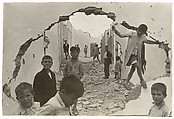Seville
Henri Cartier-Bresson French
Not on view
In 1927, Henri Cartier-Bresson enrolled in André Lhote's academy in Montparnasse to study the technique and theory of Cubist painting. The son of a wealthy textile merchant, he extricated himself from his conservative bourgeois upbringing and entered the bohemian world of the avant-garde. In 1930 he embarked on a year of solitary travel in Africa, further distancing himself from the established patterns of Western culture. The following year, after he had recovered from blackwater fever, Cartier-Bresson picked up the camera.
His earliest photographs were made in Paris and Eastern Europe and reveal the influence of both Cubism and Surrealism--bold, flat planes, collagelike compositions, and spatial ambiguity--as well as an affinity for society's outcasts and the back alleys where they lived and worked. First with an unwieldy box camera, then in 1932 with a small 35mm Leica, Cartier-Bresson traveled to Italy, Spain, Morocco, and Mexico, developing what would become the hallmark of twentieth-century photographic style. In his 1952 monograph "The Decisive Moment," he defined his philosophy: "To me, photography is the simultaneous recognition, in a fraction of a second, of the significance of an event as well as of a precise organization of forms which gave that event its proper expression."
This photograph of children playing amid ruins is typical of Cartier-Bresson's early work. A masterpiece of photographic surrealism, the image is filled with surprises that challenge even the most acutely observant viewer. A small army of children play in a very unchildlike environment; some address the camera, others continue their activities undisturbed. The picture's space is intentionally ambiguous; the breached foreground wall acts both as a window to the background drama and as a stage or backdrop for the foreground actors. The photograph seems at first glance to be a collage of cut-out elements rather than a photograph made with a single exposure. The white paint on the stuccoed wall even blends with the photograph's white borders, suggesting that the four boys closest to the camera have literally broken out of their world by tearing a hole in the print itself.
[JLR; Waking Dream, pp. 363-364]
This image cannot be enlarged, viewed at full screen, or downloaded.

